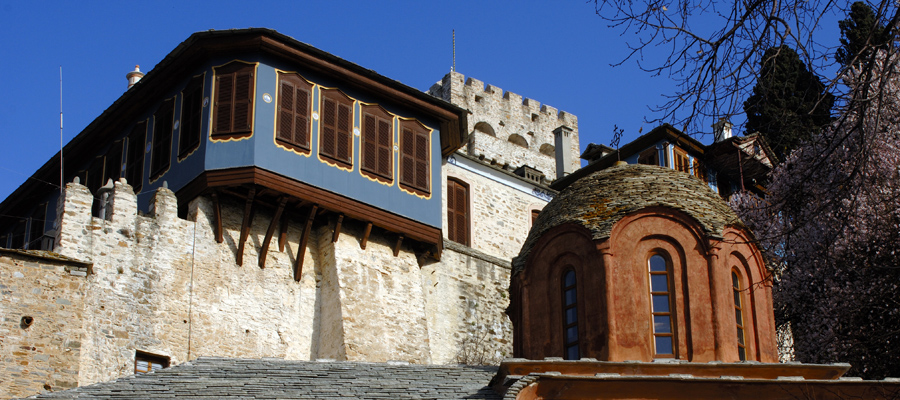Dochiariou monastery
The coastal building complex is built amphitheatrically in the southwestern side of the Athonite peninsula, towards the port of Daphne. Its ground plan forms an irregular five-sided shape, with the dominating defensive tower next to the gate. Its murder-holes protected the entrance during the difficult years of the pirate raids. It has 5 storeys and is 28m in height. It has a tank in the basement that is supplied with water from the fountain at the base.
According to tradition, Osios Efthimios, a student and fellow ascetic of Athanasios the Athonite, founded the monastery in late 10th century. He had been “dochiaris”, probably in Megisti Lavra, i.e. he was responsible for the food pantry. Researchers claim that the monastery was probably transferred to a new location in the mountains between 1083 and 1108 and was transferred in its current, coastal location between 1083 and 1108. It was dedicated to Archangel Michael in early 12th century. Abbot Neophytos, second founder of the monastery, built a larger Catholicon and raised the defensive tower.
A prosperity period followed the difficult times of the pirate raids of the 13th and 14th centuries. It was supported financialy by John V Palaiologos and the Serbian ruler Stephen Dousan. Ottoman rule worsened the situation, but in the 16th century it found support by the ruler of Moldovlachia, Alexander and his wife Roxandra, who helped regain its properties from the Ottomans. It is remarkable that, unlike other monasteries, it never suffered the disasters of a fire. However, in the 1821 Revolution, it lost all its movable assets.
Its tower was renovated in early 17th century, and it was declared a Stauropegic in 1660.
Archangels Michael and Gavriil are celebrated in the Catholicon. The frescoes of the church was made in 1568 and is attributed to famous painter Theofanis. The base of the main dome is 15m from the floor, in order to light the inside due to its adjacency to wings. The will of Abbot Neophytos written on a fabric of a priceless veil located in the sacristy is impressive.
Text: Dr. Antonios G. Dikaios/ Theologian – Environmentalist.






